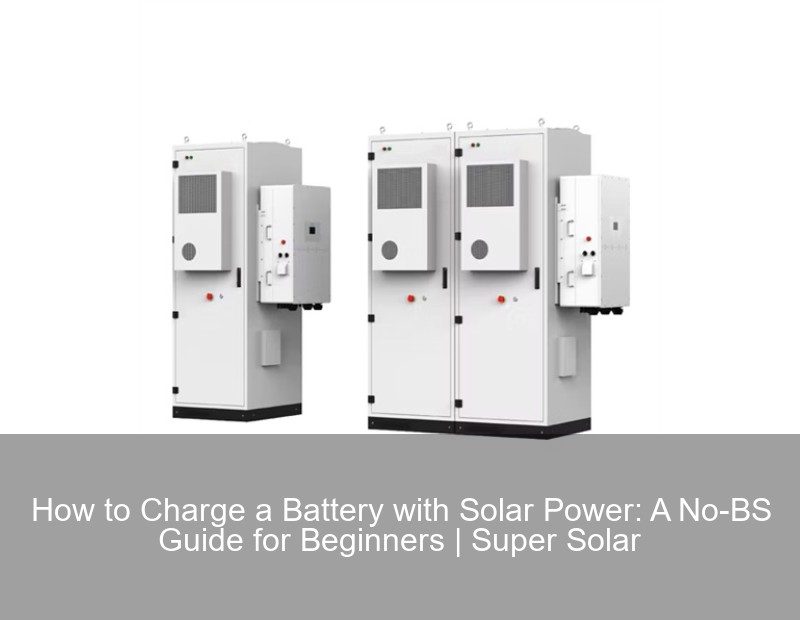How to Charge a Battery with Solar Power: A No-BS Guide for Beginners

Why Solar Charging Isn’t Just for Hippies Anymore
Let’s face it—charging a battery with solar power used to be a niche hobby for off-grid enthusiasts. But with rising electricity costs and cooler tech hitting the market, even your neighbor’s cat might be considering a solar setup. In 2023, the global solar battery market grew by 89%, proving this isn’t just a passing trend. So, why bother? Well, imagine never paying for campground fees again or keeping your fridge running during a blackout while others eat melted ice cream. Sounds tempting, right?
What You’ll Need (Spoiler: It’s Not Magic)
- Solar panels – The rockstars of your setup. Go for monocrystalline if you want efficiency, polycrystalline if you’re budget-conscious.
- Charge controller – Think of it as the “bouncer” that prevents your battery from overcharging.
- Deep-cycle battery – Lithium-ion is the new MVP, but lead-acid works if you’re feeling retro.
- Inverter – Converts solar DC power to AC for your gadgets. Unless you’re powering a 1990s Walkman, you’ll need this.
Step-by-Step: Charging Your Battery Without Setting Anything on Fire
1. Panel Placement: Sunbathing 101
Position your solar panels like you’re staging Instagram photos—angles matter! A 30-45 degree tilt facing true south (northern hemisphere) maximizes sun exposure. Pro tip: Use a $5 smartphone app like “Solar Panel Angle Calculator” instead of eyeballing it. We’ve all seen those DIY fails where panels face a brick wall.
2. Wiring: Don’t Cross the Streams
Connect panels in series for higher voltage (great for long cable runs) or parallel for higher current. Mess this up, and you’ll get the performance equivalent of a sloth on melatonin. For small setups, a simple 100W panel with 10AWG cables usually does the trick. And no, duct tape isn’t a valid connector.
3. Charge Controllers: MPPT vs. PWM (The “Tesla vs. Horse Cart” Debate)
MPPT (Maximum Power Point Tracking) controllers squeeze 30% more efficiency from your panels by adjusting voltage dynamically. PWM (Pulse Width Modulation)? It’s like using a dial-up modem in a 5G world—cheaper but outdated. Case in point: A Colorado camper reported 20% faster charging after switching to MPPT. Worth the splurge.
Real-World Hacks Even Your Grandpa Would Nod At
- Battery maintenance: Lithium batteries hate the cold more than your ex. Keep them above freezing.
- Partial shade is the enemy. One shaded panel can tank your entire system’s output—like one bad avocado ruining guacamole.
- Got clouds? A 2022 study found bifacial panels (which capture reflected light) can boost output by 11% on overcast days.
When Things Go South: Troubleshooting 101
If your battery charges slower than a sloth marathon, check for:
- Dirty panels (bird poop is not a solar accessory)
- Loose connections (wiggle those wires like you’re checking Christmas lights)
- Outdated firmware on smart controllers (yes, even solar tech gets software updates)
The Future of Solar Charging: More Than Just Hype?
Trend-spotting time: Perovskite solar cells promise 40% efficiency (up from today’s 22%) and could hit markets by 2025. And get this—researchers are testing solar fabrics. Imagine charging your phone through your t-shirt while hiking. Mind. Blown.
Final Pro Tip: Don’t Be a Solar Snob
You don’t need a $10,000 setup to start. A humble 50W panel + battery kit can power lights and phones for weekend trips. As one Reddit user put it: “My $200 solar setup brews my coffee every morning. Take that, Starbucks!”
So there you go—no PhD in photovoltaics required. Whether you’re prepping for the apocalypse or just want free energy for your backyard pizza oven, charging a battery with solar power is simpler than assembling IKEA furniture. Mostly.